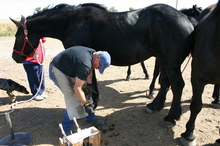The idea that working horses can be barefoot is not new. Horses have a long history of barefoot performance and have carried fully armoured men into battle. They have been used for fieldwork, war and performance in their natural barefoot state.

Farrier checking horse's hoofs
We call the Vet because our horse is lame, and too often the horse is diagnosed as âNavicularâ; however, instead of treating the cause by re-establishing natural hoof function, we treat the symptom.
The hoof is a miraculous structure designed with innate intelligence to function as support for the weight of a horse in movement. In its natural state, when a horse's full weight descends, the hoof is sandwiched between that load and the ground. The hoof spreads apart, allowing the coffin bone to drop, like a trampoline. This is the natural shock-absorbing feature of the hoof. The walls spread (up to 6mm from side to side) and the sole draws flat.
The question is: When metal is nailed in all around, how can the hoof function properly? Where is the shock absorbed? Perhaps it's absorbed in the sensitive tissue of the hoof or further up the structure of the leg.
The proliferation and growing use of products containing glucosamines, MSM and anti-inflammatories is a result of our inadequate understanding of the shock-absorbing features of the hoof. Allowing our horses hooves to function more naturally will show a decrease in their symptoms of pain and discomfort.
The metal shoe is nailed on with the idea of protecting the hoof, or with no real goal but just because it has always been so. The shoe is nailed on when the hoof is in the air, at its smallest, most contracted shape.
Since the metal shoe freezes the hoof in this contracted position, the hoof cannot expand and contract with weight-bearing or movement, and there is no room for the coffin bone to properly descend. So as the coffin bone pushes down under the horse's weight, it bruises the solar corium because the sole cannot draw flat to get out of the way.
The pain caused as a result of bruised solar corium is often sadly diagnosed as Navicular Syndrome. We must ask, âIs it the pressure from the descending coffin bone or is it the damaged bone that is painful?â Under X-rays the bone is shown to be deteriorating. Enlarged holes and passageways through the bone are a result of congested blood.
Lack of circulation causes the arteries to swell, which pushes against the bone, causing deterioration to bone spongiosa. Itâs often the lack of blood circulation that is the real cause of bone corrosion. Pain is an additional result, through irritation of connective tissue, stress on ligaments and tendons, and bruising when bone tissue meets corium.
We call the Vet because our horse is lame, and too often the horse is diagnosed as âNavicularâ. However, instead of treating the cause by re-establishing natural hoof function, we treat the symptom: we have bar shoes applied and the horse walks off, supposedly sound.
We think the bar shoes are an extraordinary cure, when what is really happening may be just the opposite. Even less circulation! In a normal horseshoe shape the frog will still make some contact with the ground and allow the blood to pump in that area.
With a bar across the heel circulation is fully limited. The horse can walk because he cannot feel his feet. His hoof is numb and the internal damage continues.
Pain medication can mask the condition. Surgery is questionably risky. Both have negative side effects. Either way, pulling off the metal shoes and rehabilitating the hoof to perform its natural function is the only way to correct the condition. The choice is yours.
Carole Herder has been involved in horse health since 1994. She speaks publicly on the benefits of keeping horses barefoot and as close to their natural state as possible. Her company Cavallo Horse & Rider Inc. develops, manufactures and distributes horse products in 29 countries worldwide. Carole and her partner Greg Giles designed and patented Cavallo Sport, Simple and Trek Hoof Boots. They work rigorously to develop and create products that provide comfort and protection for both horse and rider.
By Carole Herder, President of Cavallo Horse & Rider
